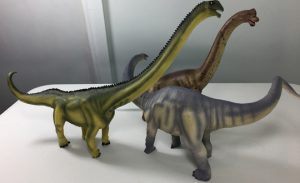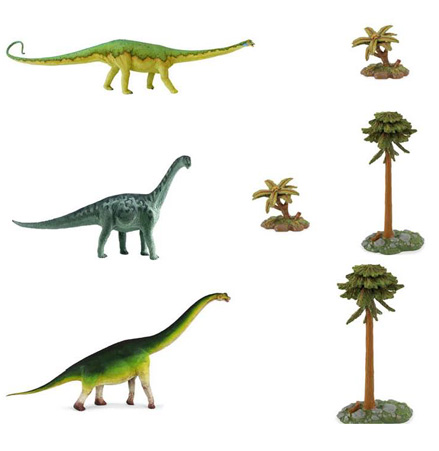Remarkable Ostrich Necks Provide Information on Sauropod Neck Flexibility
Those Not so Flexible Sauropods
The Sauropoda, that group of large, lizard-hipped dinosaurs with their long necks, huge bodies and long tails* have fascinated palaeontologists ever since the first enormous fossil bones of these plant-eaters were discovered. Most natural history museums, if they are big enough, will feature sauropods amongst their dinosaur exhibits. Although much has been learned about these Late Triassic to Late Cretaceous creatures since the days of Marsh, Cope and Riggs, palaeontologists still puzzle over many aspects of their anatomy. For example, just how flexible were those long necks?
Sauropod Dinosaur Neck
New Study into the Long Necks of Sauropoda

A new study has been published that looks at the flexibility of sauropod necks. Picture credit: Everything Dinosaur.
Collaborative Study
In a new, collaborative study between researchers from the University of Utah, the Natural History Museum (London) and Bristol University the neck bones, and soft tissues of the necks of female ostriches have been used to try to model the flexibility of sauropod necks. Why does this matter? Well, the flexibility of the neck has all sorts of implications for the Sauropoda. For example, very flexible sauropod necks would imply that these animals could reach high to feed on the tops of trees, or dip their heads very low to feed at ground level.
This feeding range, often referred to as the “feeding envelope” can be examined and contrasted amongst different sauropod genera permitting scientists to understand more about the feeding habits of certain species that co-existed.
Ostriches Studied
Previous studies had focused on the articulation and degree of movement possible by examining the cervical vertebrae (neck bones) of sauropods. In this study, the team examined the bones and soft tissue found in ostrich necks (Struthio camelus), ostriches were chosen as they too, have elongated necks and the soft tissue such as muscle groups in the neck region are broadly comparable with that of sauropods.
The researchers measured the flexibility of the flightless birds with all their muscle tissue intact, and then slowly removed the muscles to test how this changed the situation and altered the range of movement possible. The team’s findings suggest the soft tissues and cartilage associated with the long-necks of sauropods would have restricted their neck movements. This has implications for the way these dinosaurs are depicted in films, books and displayed in museums.
Matthew Cobley from the University of Utah, one of the authors of the scientific paper that has been published in PLoS One (Public Library of Science) commented:
“Previous studies looked at the skeleton on its own and the assumption was that flexibility is limited by the bones of the skeleton, but our study shows it’s actually the soft tissue around it.”
The Impact on Feeding Strategies
The flexibility of the necks of these herbivores will have an effect on the feeding strategies that these creatures can adopt. There is a wide degree of variation in the shape of the cervical vertebrae, their number and the length of the neck in sauropods. Each type of sauropod would most likely, have adaptations for exploiting food resources within a given environment.
Dinosaurs with different necks and other adaptations could reach and feed on different types of vegetation. With variation in feeding habits, an ecosystem could support a more diverse range of mega-herbivores.
Variation in Sauropod Necks – Adaptations for Different Feeding Strategies Perhaps?
Picture credit: Everything Dinosaur/Safari Ltd
Different Sauropod Feeding Strategies
In the illustration above, examples of different sauropod anatomies can be seen, from diplodocid (top), camarasaurid (middle) and brachiosaurid (bottom). The necks of these animals are very different, suggesting that each type of long-necked dinosaur was adapted to feeding on certain types of vegetation. The diplodocids may have been browsers, whilst the brachiosaurs may have been better suited to feeding from the tops of trees.
It has been calculated that some large species would have had to consume as much as 400 kilogrammes of vegetation a day to sustain their immense bodies. A herd of these herbivores would very quickly strip an area of suitable plant matter. The competition for food amongst different species would drive the evolution of more specialised feeding and this may help explain why there is a large variation of sauropod species found in places such as the Dashanpu Quarry fossil sites in Sichuan Province, China.
These Jurassic aged sediments have revealed the fossilised bones of at least four different types of long-necked dinosaur. Each was very probably adapted for feeding in a certain way. Sauropods such as Mamenchisaurus and Omeisaurus with their extremely long necks would have specialised in one feeding method, whilst their contemporary, Shunosaurus with its much shorter neck would have probably browsed on other types of vegetation.
* Not all members of the Sauropoda were huge. This is a very diverse group of Dinosauria, some sauropods such as the titanosaur Magyarosaurus from the Hateg Formation may have reached lengths no longer than four metres and perhaps this dwarf titanosaur might have weighed about the same as a modern dairy cow.
For models and replicas of sauropods and other herbivorous dinosaurs: CollectA Prehistoric Life Models and Figures.


